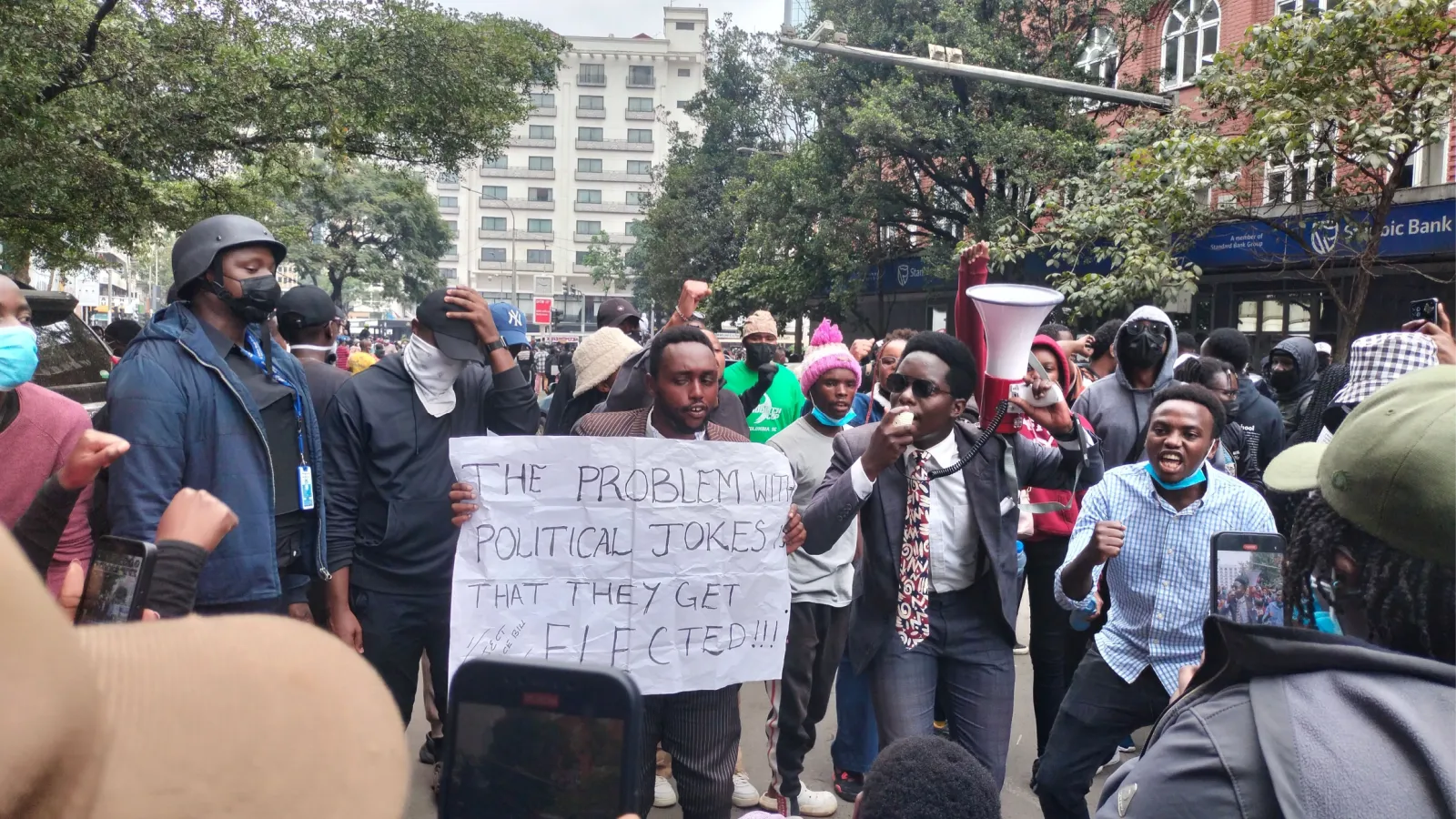
Kenyans are turning to crypto to make ends meet in the face of widespread unemployment and distrust of President William Ruto. As nationwide protests continue, sources in Kenya told Decrypt youth in the country long to break free of the financial system now more than ever—and many of them believe creating a crypto wallet is the first step.
In an attempt to reduce the country’s debt, the Kenyan government sought to raise money through taxes. This included new levies on basic items such as a 16% sales tax on bread and a 25% tax on vegetable oil. An “eco levy” was also proposed and would have seen the price of menstrual products rise—an item that many women in Kenya already struggle to afford.
Protests broke out across the nation in response to the controversial bill. On Tuesday, the Parliament building in Nairobi was set on fire and the demonstrations turned fatal. On Wednesday, Kenya’s President Ruto withdrew the bill.
But for many Kenyans, the distrust remains.
‘Fires seen inside parliament building in Nairobi.’
Five protestors have reportedly been killed after they overwhelmed police to storm the compound where lawmakers had just passed a bill that would introduced a raft of new taxeshttps://t.co/YVtqmVIV5K
📺 Sky 501 pic.twitter.com/lnse6z9CSs
— Sky News (@SkyNews) June 25, 2024
“We are not satisfied at all with this and are demanding the resignation of the president,” Kenyan activist and self-proclaimed cultural ambassador Martin Kittony told Decrypt. “It feels like his grip on power is gone.”
At least 24 people died last week. Sources there told Decrypt they expect that number to rise as the government deploys the military to restore order in the country. The rally against the government has largely been led by the Kenyan youth, who feel the government has failed them repeatedly. In the face of scarce employment, they’ve looked to crypto as a new viable way to make money.
The Kenyan youth, whose ages range 15 to 34, led these protests displaying their disillusionment with the state of the country. This age group accounts for 35% of the Kenyan population and, according to The Federation of Kenya Employers, faces a 67% unemployment rate—the highest of any group in the country.
Airdrop farming and play-to-earn
“We pay taxes, but we don’t know exactly where the money is going,” an unemployed 32-year-old Kenyan told Decrypt. “I have never seen anything this government has done. Just promises.”
This source, along with several others in this story, asked not to be named for fear of retaliation from the government.
The unemployed 32-year-old lives in a rural village, far outside of the two major cities, Nairobi and Mombasa. He’s lived there most of his life and said he’s never seen the government use taxes to uplift his community.
As a result, the people of the country have been looking for alternative ways to earn money.
One group has formed around a Solana meme coin called Matatu. They have been using the protests as a way to push cryptocurrencies as a new way to earn money.
Another Kenyan protestor, a 28-year-old technology consultant, told Decrypt that he believes farming airdrops, engaging with token giveaways, and creating content for meme coins is a better way for people to earn money than traditional routes available in the country.
He explained that 1 SOL ($147) is worth more than one month’s minimum wage in Kenya and believes that this “could definitely be earned over time” by engaging with crypto projects.
An airdrop is essentially a crypto token giveaway that rewards people who have used and helped build a project. Free coins could be viewed cynically as a marketing stunt, though many crypto projects use airdrops as a way to distribute tokens as widely as possible. Although crypto wallets are anonymous, a project can see which wallets have interacted with it, how frequently, and then grant rewards based on a user’s engagement.
There are other ways to “earn” crypto from projects, like play-to-earn games.
This is reminiscent of when the play-to-earn Ethereum game Axie Infinity saw players in countries like the Philippines and Indonesia attempt to support their families with their crypto rewards. Users were rewarded with tokens for their in-game progression. And for some time, roughly 40% of Axie Infinity’s player base was based in the Philippines.
But it was short-lived as the game’s economy has since crumbled.

Kenyans took to the street to protest the government’s controversial bill. Image: Shutterstock
Crypto wallets and lower fees
“During the protest we were teaching people how to set up Phantom wallets, and how to buy Solana,” Kittony said. “The youth were excited about the idea of controlling their money, giving power back to the people.”
As Kenyans look at the state of their country, he added, they fear that the Kenyan shilling, the local currency, will become unstable.
Over the past five years, the Kenyan shilling has fallen 19.5% against the U.S. dollar, according to Google Finance. To put this into perspective, the Great British pound has slipped just 0.3% over the same period.
“Whereas crypto’s value is only increasing,” Kittony said. “This is something the Kenyan youth are very aware of. The challenge is educating youth on this widely.”
Fortunately, Kenya has a head start when it comes to working with digital money.
Throughout the country, 96% of Kenyan households include at least one person who uses the mobile money app M-PESA. The app can be used to deposit, withdraw, and send money to other people and businesses. But although it’s a popular solution, locals have complained that M-PESA’s fees are too high.
“If someone were to send 200 KES home, he’d attract a 7 KES charge for transfer and 29 KES withdrawal fee for cash—that’s 18% of the money,” the 28-year-old Kenyan technology consultant explained. “Whereas blockchain networks have super cost effective fees that make it much more equitable.”
The Kenyan population are already familiar with using their mobile to send and receive money. So, the next step is swapping this for a crypto app, the consultant told Decrypt.
One hurdle here is that M-PESA can work on any phone, including basic feature phones. But most crypto apps need to be run on smartphones—although there have been attempts to bridge this gap.
Even so, broad adoption of crypto faces some strong headwinds.
Despite military patrols on Kenya’s streets, the anti-government uprising and protests continue, ignited by suffocating IMF-backed tax reforms. President William Ruto rescinded plans for the bill, but this move failed to quell the protests, which have now escalated beyond tax… pic.twitter.com/gYnwglPcP2
— red. (@redstreamnet) June 27, 2024
Worldcoin’s long shadow
In 2023, Worldcoin started scanning people’s eyes and issuing its WLD token in Kenya. Thousands queued up at registration centers last year. But then Kenyan authorities suspended Worldcoin amid privacy concerns, comparing the project to a “gang of criminals.”
Worldcoin is a digital identification platform that proves your “personhood” in an attempt to battle the current and future threat of artificial intelligence. Led by OpenAI CEO Sam Altman, people could get their eyes scanned by an “Orb” which would verify their “personhood” granting them access to the blockchain platform. Users can verify credentials without the need of revealing their entire identity by using the World App on top of storing crypto. In exchange for signing up, you’d receive roughly $49 in the project’s crypto token WLD.
Kenya wasn’t the only country to reject the project though. Authorities in most countries were alarmed when the silver iris-scanning Orbs started to appear.
France and Germany, for example, coordinated an investigation on the legality of the project. They concluded that it seemed “questionable.” Aside from legal repercussions, an MIT Technology Review investigation found that the project didn’t fully explain issues surrounding privacy to those having their irises scanned in low income countries such as Kenya, Sudan, and Ghana. In spite of this, the company claims to have on-boarded over 10 million users, in a serious step towards widespread adoption.
With Worldcoin as their predecessor, blockchain educators could face an uphill battle.
“Most of the conversations [in Kenya] are around pushing for more blockchain education, considering how decentralized this movement has been,” Sherie Margaret Ngigi, a Kenyan NFT artist, told Decrypt, “No one is a leader in this movement and people are using their phones to mobilize resources and information.”
As fighting rages in Nairobi, there are people braving clouds of tear gas to educate protesters about crypto or help them set up Phantom wallets. Resources are spreading through WhatsApp and Twitter while the government denies claims that it attempted to shut down the nation’s internet.
“It’s become a really tricky situation at the moment, the military has been deployed,” the 28-year-old Kenyan technology consultant said. “If we can improve one person’s life, it’s worth it.”





